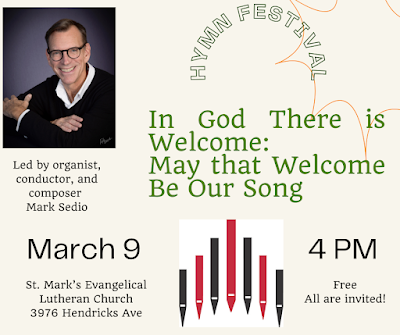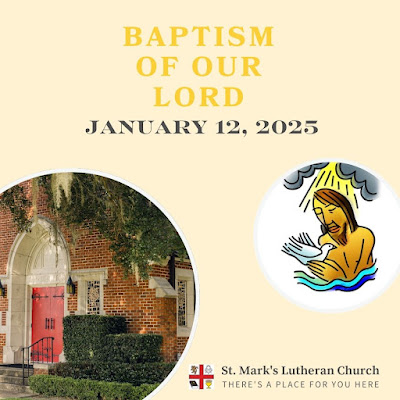ADVENT LESSONS AND CAROLS
The format for Christmas Lessons and Carols dates back to 1880 at Truro Cathedral in Cornwall, England where it was first sung on Christmas Eve. Today's service is Advent-themed, featuring writings from the Prophet Isaiah and two of the four canonic gospel writers.
 |
| Truro Cathedral |
OPENING MUSIC A Call to Advent J. Jerome Williams
Yes, this is usually the spot for an organ voluntary, but today the Festival Choir presents a quodlibet - a form of musical composition that combines melodies. Here are two of the best-know Advent melodies: Veni, Emmanuel ("O Come, O Come, Emmanuel") and Picardy ("Let All Mortal Flesh Keep Silence").
We often think of Advent's meaning as two-fold, Jesus' incarnation at the manger in Bethlehem, then his coming in glory at the end times. Using Picardy this early in the service also allows to reflect on another way Jesus comes to us - in the mystery of the Eucharist.
The second stanza (not included in this piece)refers to Jesus as "Lord of Lords in human vesture, in the body and the blood" and tells us "he will give to all the faithful his own self for heavenly food."
GATHERING HYMN SAVIOR OF THE NATIONS, COME (Nun komm der Heiden Heiland) ELW 263
Some version of the hymn has been sung by Christians for more than 1,600 years! Ambrose of Milan (340-397) wrote the Latin hymn that Martin Luther eventually translated into German.
The first three stanzas speak of the incarnation - a definite theme in Advent. Stanza four speaks of Christ's triumph over death and his being seated at God's right hand. The fifth stanza gives us a little glimpse of Christmas before the final stanza in praise of the Trinity.
FIRST LESSON Isaiah 64:1-9
God commissions Isaiah to be the Prophet of the Advent.
The Night Will Soon Be Ending (Llangloffan)
 |
| Isaiah, by Antonio Balestra (1666-1740) |
Night is a common theme in Advent Hymns: "Lost in the Night," "Watchman, Tell Us of the Night," "Wake, Awake, for Night Is Flying."
We think of the people who "walked in darkness," as being people from ancient times, but we still experience darkness today, in both or personal and our collective lives.
The author of this text, Jochen Klepper (1903-1942) lived under the power of the Third Reich in Nazi Germany. The experiences he endured with his family brought insomnia and vivid nightmares. This may have been a life-long situation, but Klepper bore it with the assurance that even when nights bring sadness and "rob our hearts of peace," God dwells with us, redeems us from sin, and claims us as children.
Klepper married a woman from a Jewish family and they had two daughters. His wife, Johanna Stein, was baptized just prior to their wedding. When his daughter was denied a visa, the three of them turned on a gas valve in their home and died by suicide. Klepper's last words, recorded in his diary, were, "Tonight we die together. Over us stands in the last moments stands the image of the blessed Christ who surrounds us. With this view we end our lives."
This hymn comes from Lutheran Service Book, the current hymnal in use by the Lutheran Church Missouri Synod.
SECOND LESSON Isaiah 9:2-7
God promises a child who will bring peace.
Lost in the Night (Lost in the Night) ELW 243
 |
lighting candles for and
evening service at St. Mark's |
You can feel the mourning and pleading in this Finnish melody. The last line of each stanza is repeated, giving a sense of urgency that is only emphasized by using the word "soon."
Will not day come soon? Will not day come soon?
Will you help us soon? Will you help us soon?
Christ is coming soon! Christ is coming soon!
Come and save us soon! Come and save us soon!
THIRD LESSON Isaiah 65:17-25
God promises a new creation.
Joy to the World (Antioch) ELW 267
"Finally! A Christmas carol!" This may be the first thought of some, but let's examine the text. Where is the manger? Where are Joseph and Mary? Where are the shepherds?
You can look, but I promise you won't find them because this hymn is about Jesus' second coming! So, it's an Advent hymn and not a Christmas one. (But you can still feel happy about singing it!)
FOURTH LESSON Luke 1:26-38 |
First United Methodist Church
Gainesville, FL |
The Angel Gabriel salutes the Blessed Virgin Mary.
A Stable Lamp Is Lighted Mark Sedio
Sung by the Festival Choir, this text by Richard Wilbur (1921-2017) ponders the words of Gabriel in a poetic manner, foreshadows the passion and crucifixion, and ends with a reminder that the reason for the incarnation is for creation to be reconciled to God, including us.
FIFTH LESSON Luke 1:39-45
The Blessed Virgin Mary visits her cousin Elizabeth.
My Soul Rejoices (In dir ist Freude)
If I had to choose a favorite gospel, I would choose the gospel of Luke. Why? Because it's where all the songs are, the first one being Mary's "Magnificat anima mea" (My soul magnifies the Lord).
The metrical setting we sing today also comes from Lutheran Service Book. Stephen Starke's text is paired with the dancing Lutheran tune In dir ist Freude, most often sung with the text In Thee Is Gladness.
Other songs from Luke's gospel include the Song of Zechariah (which we sang last Sunday), Glory to God in the Highest, and the Song of Simeon (Lord, Now You Let Your Servant Depart in Peace).
This hymn also comes from Lutheran Service Book.
SIXTH LESSON Matthew 1:18-23
St. Matthew tells of the coming birth of Jesus.
Love Has Come (Un flambeau) ELW 292
We conclude with another dancing tune, the one used for the French carol Bring a Torch, Jeanette, Isabella. A true Christmas hymn/carol, it serves as a joyful endpoint for our service of Advent Lessons and Carols.
 |
St. Peter's Lutheran Church
Port Jervis, NY |
MUSICAL OFFERING O Come, O Come, Emmanuel Gordon YoungWe welcome Jane Daugherty to play the musical offering today. Jane has been a member of St. Mark's for many years and often serves as a substitute organist when I am away.
Jane is also one of two musicians who serve as organist/choirmaster at St. Andrew's Episcopal Church in Arlington.
When she is not at St. Andrew's, or substituting somewhere else, she is a valued member of our Festival Choir.
She's also my good friend.
COMMUNION HYMN In a Deep, Unbounded Darkness (Divinum Mysterium) ACS 1093
This text that originated as a theme song for a Bible study institute in China is a meditation on the eternal nature of God. Like the hymn Of the Father's Love Begotten, with which this tune is often paired, we begin in the time before creation when God claimed us. After praising God's steadfastness in stanza two, our joy overflows at the incarnation in stanza three. Finally, stanza four returns us to the realm of eternity, joining together the beginning and final chapters of the Bible by connecting references to stories from Genesis and Exodus with the wedding feast of the Lamb in Revelation. (Sundays and Seasons)
SENDING HYMN O Come, O Come, Emmanuel (Veni, Emmanuel) ELW 257
CLOSING VOLUNTARY Fugue on "Savior of the Nations, Come" Jacob B. Weber
Sources:
Hymnal Companion: Evangelical Lutheran Worship (Augsburg Fortress)
Lutheran Service Book Companion to the Hymns
Wikipedia
Image of Truro Cathedral: By Tim Green - originally posted to Flickr as Truro Cathedral, CC BY 2.0, https://commons.wikimedia.org/w/index.php?curid=6432493
Isaiah painting: By Antonio Balestra - Bridgeman Art Library: Object 569354, Public Domain, https://commons.wikimedia.org/w/index.php?curid=25016733

































